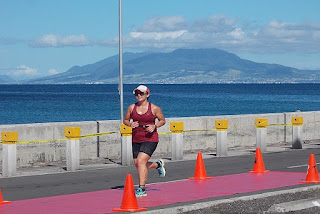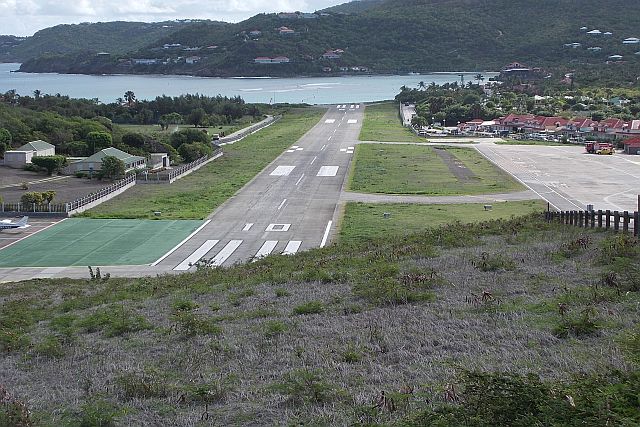 |
| Sugar was once the primary source of revenue for Nevis -- Today it's tourism, but you can still relive the past (Taylor) |
NEVIS –
Nevis just may
be the Rip Van Winkle of the Caribbean . The
sleepy little island nestled just across the channel from its big sister St.
Kitts is in a quiet corner of the world all its own.
Nevis is a perfect synonym
for serenity where the biggest event of the day is usually the sunrise with its
promise of perpetual solitude in paradise.
 |
| Avenue of the Palms at Nisbet Plantation (Taylor) |
Nobody really knows how Nevis
got its name which is derived from the Spanish Nuestra Senora de las Nieves meaning “Our Lady of the Snows.” The
reference comes from a rare snowfall on the Esquiline Hill in 4th
century Rome Nevis Peak
which apparently reminded someone of the miracle snow in Italy
 |
| Looking across the "Narrows" toward St Kitts (Taylor) |
Situated
a little more than 200 miles east-southeast of Puerto Rico, Nevis and St Kitts gained
their independence from the United
Kingdom
Most
visitors arrive in Nevis by water taxis that take
approximately 10 minutes from St. Kitts, but the island does have an airport which
can accommodate small planes.
For a
tiny place, Nevis has a rich history which it
ingeniously uses to promote modern day tourism. When Pierre Le Moyne
d’Iberville, the French Canadian founder of Louisiana
decided to drive the English out of Nevis in
1706, many plantation owners burned their property rather than allowing the
French to take control.
Ironically,
it was primarily the African plantation slaves who took up arms to defend their
families against the French invaders.
 |
| Golden Rock Plantation is famous for its lush gardens (Taylor) |
Two
important consequences resulted; the sugar industry ultimately collapsed and
small plots of land from the plantations were offered to the previously
enslaved families. Today, Nevis has a
population of roughly 12,000 inhabitants who are mostly of African decent.
When
slavery was abolished in 1834, the first Monday in August was set aside as
Emancipation Day as part of the island’s annual Nevis Culturama Festival.
 |
| Typical cottage at Nisbet Plantation (Taylor) |
But given
its laid back personality, there are other historical aspects to Nevis which are fascinating. British naval hero Admiral Lord Horatio
Nelson was married to the 22-year old daughter of a plantation owner there in
1787. Frances (Fanny) Nisbet lived at Nisbet Plantation, one of four sugar
plantations that have been renovated into upscale resorts.
The first
United States secretary of
the treasury, Alexander Hamilton, was born on Nevis
and spent the first years of his life there.
Other
natives include Rupert Crosse, the first African American to be nominated for
an Academy Award for Best Supporting Actor and actress Cicely Tyson who has won
multiple Emmys and was nominated for an Oscar in 1972.
 |
| Remnants of its sugar history at Nisbet Plantation Resort, once the home of Fannie Nisbet wife of Lord Nelson (Taylor) |
Even
lesser known, but no less important, is the story of Captain John Smith who
visited Nevis while sailing to Virginia Jamestown was founded in the New World .
Yet, with
such a rich history, time still passes slowly on the island of Nevis
 |
| Bath Hotel and Spa was the first hotel in the Caribbean -- It is now an office building but the hot springs remain (Taylor) |
Electricity
wasn’t introduced until 1954, but it was not available throughout the island
until 1971. Despite that, Nevis was home to the first hotel in the Caribbean , the luxurious Bath Hotel and Spa built by John
Huggins in 1778. Huggins created his property to take advantage of the small
but soothing medicinal waters of the nearby hot spring fed by the thermal
activity of Nevis
Peak
 |
| The thermal baths of Nevis fed by Nevis Peak (Taylor) |
Though
the hotel is now an office building, the hot
springs
Each of
the former sugar plantations that has been converted into resorts features its
own charm and character. The deluxe Four Seasons Hotel is the only chain hotel
on Nevis as well as the only Four Seasons hotel in the Caribbean .
Life on Nevis centers around the water. Pinney’s Beach, on the
western coast, is the most developed beach on the island.
 |
| Five star luxury of the Four Season Hotel on the tiny five star island of Nevis (Taylor) |
Though
tourism thrives, the island is too small to accommodate large cruise ships. With
400 hotel rooms, half of which belong to the Four Seasons, Nevis ’
goal is not to add more hotels but to fill the rooms they already have.
 |
| Montpelier Resort is near the site of the wedding between Admiral Lord Nelson and Fannie Nisbet (Taylor) |







































